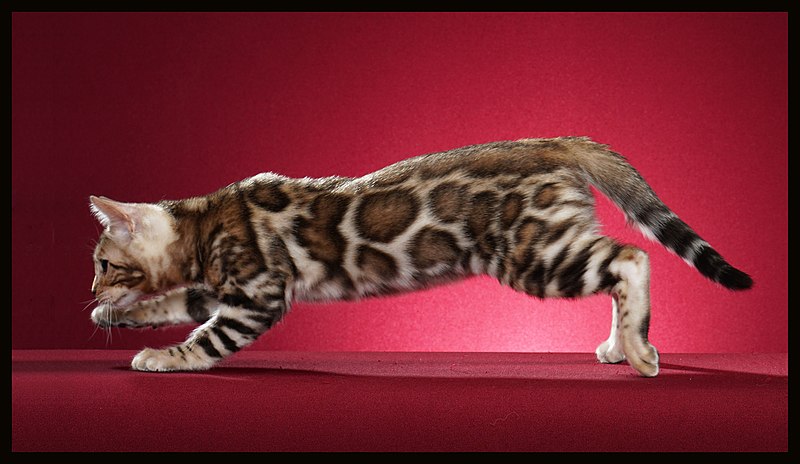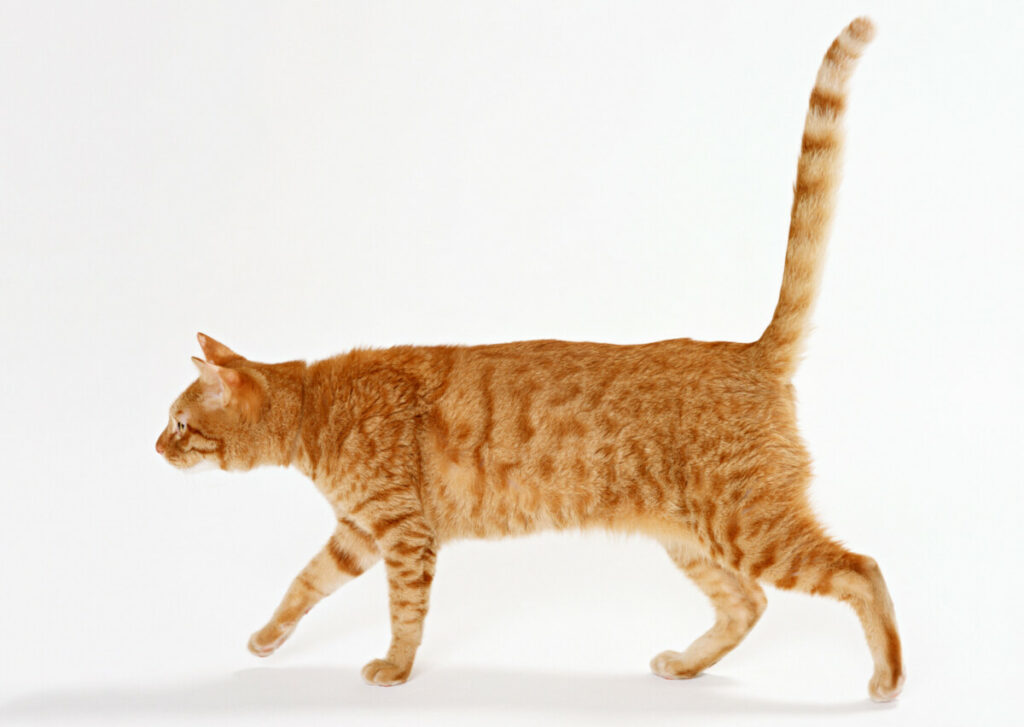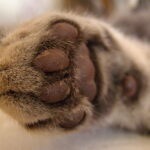Have you ever observed your cat’s tail? It is a continuation of their spine. Not only that, but your cat’s tail aids in body balance. Let’s look at the tails of Bengal cats.
Bengal cats, like all other cats, have a tail. Signaling mechanisms can be found in your Bengal’s tail if you look closely. Their tails are used to express their emotions. A twitch, for example, can imply slight discomfort, and a tail wrapped against a cat’s body can suggest nervousness.
Furthermore, cats’ tails are an essential part of their bodies and are extremely sensitive. If you examine your Bengal cat’s tail, you can learn a lot about its behavior. Furthermore, the tail of this breed has several features worth mentioning. To understand your Bengal cat’s behavior, you must first understand its tails. So, this post was created to tell the story of Bengal cats’ tails!
This post will cover everything you need to learn about your Bengal cat’s tail. So, without further ado, let us begin our tale of the tail!

Are all Bengal cats born with their tail?
Bengal cats are one of the most majestic-looking cat breeds out there. These cats are smart, regal, and hyperactive. And one of their special features is their tails.
All Bengal cats are born with their tail under normal circumstances. As a result, they tend to have a longer tail that exactly matches their body coloration and patterns.
Bengal cat tail features
Cat tails, like dog tails, reveal a lot about their temperament. There are several distinguishing characteristics of Bengal cat tails.
Here are the top characteristics of your Bengal furbaby’s tail.
Length
Bengal cats have longer bodies than most domestic cats. However, experts believe that their tails are generally the same size. The majority of Bengals have tails that are about 10 inches long. However, in some cases, the length of their tails can range between 11 and 14 inches.
Thickness
Bengal cats typically have thicker tails than the ordinary domestic cat. Furthermore, the tails tend to hang low.
Tapering
Typically, a Bengal cat’s tail is tapering. It means, the tail is broader on the base and gradually gets thin towards the end. Also, the tip is rounded.
Maneuverability
The tails of Bengal cats aid in their movement. Have you ever seen a Bengal cat falling? You will notice that these cats almost always land on their feet if you have. But why? Because it is their tail that allows them to twist their bodies in the air and land on their paws.
Do Bengal cats have long tails?
Because Bengal cats have a longer body than other domestic cats, we frequently wonder if they also have a longer tail. So let us shine a light on the truth.
The answer to the above question depends on the length of the cat’s tail being compared with a Bengal cat. Nevertheless, a Bengal cat’s tail is typically equal to the average length of any domestic cat.
Let’s concentrate on the first statement in our target answer. Yes, if you compare a Bengal’s tail to a Manx cat, the former’s tail will measure longer. However, compared to Abyssinians, the latter would have a longer tail.
Please keep in mind that a cat’s tail typically has 19-23 vertebrae, which is also true for Bengals. However, breeds with innately fairly short tails, such as the Manx and American Bobtail, will have fewer vertebrae.
How long is the tail of a Bengal cat?
Even though Bengal cats are typically larger than most other house cats, their tails are usually of the same length and width. So let’s find out how long a Bengal’s tail really is.
A Bengal cat’s tail is usually 10-11 inches long. However, this length can vary and can reach up to 14 inches. Despite this, the average length of a Bengal’s tail is the same as that of a house cat. However, a Bengal cat’s tail length would vary according to the overall length of its body.
According to experts, the tail of a classic Bengal cat ought to be “thick, curved at the end, with a rounded end.” It should also be medium-length and appropriate to the overall body size.” That said, you should also remember that some Bengal cats have a thinner or shorter tail than what is found in average Bengals.
Do Bengal cats have thick tails?
Bengal cats are cross-bred cats with characteristics of both parents. So it’ll be interesting to see if they have a thick tail.
The tails of most Bengal cats are fluffier or thicker than most other domestic cats. However, it is not a necessary physical trait in every Bengal, as some Bengals have shorter and thinner tails.
Bengal cat tails are traditionally rounded at the ends, with the total tail thickness decreasing from the basal part. Furthermore, their tails are usually very soft.
Is it possible to identify a Bengal cat by its tail?
Although Bengal cats are distinguished by their distinct appearance, it is worth investigating whether their tail can also serve as an identification mark. Can you tell a Bengal apart by looking at its tail?
The tails of Bengal cats vary in length. As a result, their tail cannot be used to identify them positively. To summarize, you cannot tell if a cat is a Bengal cat simply by looking at its tail. Many other characteristics and marks must be examined to determine whether a cat is a Bengal cat.
More distinguishing characteristics such as coat patterns, color, head, tabby mark, and ears should also be mentioned. However, if you intend to get a Bengal cat as a family pet, you should not be concerned about the length or markings on its tail.
Getting a Bengal cat with a lovely attitude who will fit in with your lifestyle and family is always recommended.
What causes Bengal cats to puff their tails?
It’s amusing to watch a cat puff its tail on occasion. However, the underlying meaning may or may not be amusing every time. So let us investigate why a Bengal cat would puff its tail.
Bengal cats will puff their tail to appear larger and more overpowering. These cats have a penchant for hunting. They have a natural prey instinct. As a result, puffing their tail when attacking or angry may be common in them.
On the other hand, these cats puff their tails when they’re feeling extremely pleased and playful. Bengal owners believe puffing out their tails is not always bad or intimidating. When playing with another cat or pet, it is very common for kittens and grown up cats to puff the base of their tail.
After everything has been said, never generalize the reason for your Bengal cat’s tail puffing.
Always try to understand the underlying meaning to see if anything bothers or frightens them. It shouldn’t be difficult to distinguish between an anxious and a joyful cat. That said, a puffed tail, upright ears, and forward-pointing whiskers indicate that the cat is content and playful.
Do Bengal cats enjoy having their tails cuddled?

A cat’s tail is the last body part we often cuddle or pet. But what if we pet the tail of a Bengal cat? Will it be pleased or irritated?
Bengal cats are hyperactive. While they enjoy loving touches and strokes, they may be annoyed if their tail is petted while playing. In addition, these cats dislike obstacles in their path of play. As a result, if they are petted or cuddled, they may react aggressively.
Every cat lover should keep in mind that Bengal cats are not couch potatoes. They also dislike being cradled. You can, however, pet or cuddle their tails if they decide to nap in your lap.
Why do Bengal cats wag their tails?

Cats, like dogs, communicate through their tails. We need to look them up and learn how to read them. Let us investigate why a Bengal cat will wag its tail.
A cat’s tail is a barometer for feelings. It can wage its tail to communicate its feelings to us. Different types o feelings are expressed vis different types of tail waggings. Let’s take some examples:
Tail wagging sidewise:
The Bengal is thinking about something.
Tal quivering:
If your Bengal approaches you with a vertically straight tail, only the tip quivering, it means a welcoming sign.
Twitching:
A teaching tail may carry the message “leave me alone” but not in an angry tone.
Thrashing:
A rigorous swishing of the tail would usually mean that the Bengal is unhappy and wants to be left alone.
The sleepy flick:
While you call its name, if your Bengal is sleeping or taking naps, it will just wag its tail to say, “yes, I can hear you.”
Not just the tail wagging can tell you things about your Bengal cat. We recommend you carefully examine your cat to determine why it is wagging its tail. Remember that cats use much more than just their tails to communicate.
What is the purpose of a Bengal cat’s tail?
A cat’s tail serves multiple purposes. A similar thing can also be stated for a Bengal cat’s tail. So let’s explore what purpose these cats’ tails serve.
Balancing
Have you ever wondered how a cat can walk along the narrowest fences or on the highest of ledges without losing balance? A cat’s tail, after all, aids it in maintaining proper body balance while walking. The tail also aids a cat’s balance and accuracy when pouncing on prey.
Communication
Bengals, like other cats, communicate with their tails. However, different tail positions indicate different emotions in them. For instance, a straight tail suggests a friendly greeting to other pets, whereas a puffed tail may imply a playful or anxious personality.
Control Body Functionings
A cat’s tail contains nerve fibers. Many of these nerves aid in the control of urination and defecation. As a result, damage to their tail may be more dangerous to them than we realize.
Bengal cat tail markings
Much like Bengals’ facial markings, their tails also contain marks and patterns. Let’s understand those.
Bengal cats’ tails will have certain markings and patterns. For example, their tails can be spotted, striped, or marbled based on their genetic makeup.
Summary
So that was our presentation on the tails of Bengal cats. Bengals are a fascinating cat breed, and their tails are even more so. You can learn a lot about your Bengal cat’s disposition by studying its tail. However, if you have any other experiences with your Bengal cat’s tail, please do not forget to share them with us.




